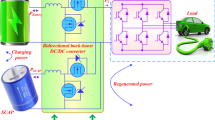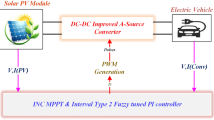Abstract
The range of electric vehicles (EVs) is still limited due to the long amount of time it takes to charge them. However, to overcome the time constraint of recharging electric vehicle batteries, fast charging stations (FCS) can be installed. These stations are capable of fully charging a vehicle's battery in just a few minutes. For this purpose, this manuscript proposes a unidirectional boost converter and Swiss rectifier-based topology to develop an FCS for electric vehicles by using a hybrid control technique. The proposed control method is a combination of both a crystal structure algorithm (CryStAl) and a random decision forest (RDF). Hence, it is called the CryStAl-RDF method. Here, the unidirectional boost converter is utilized to enhance the power factor (PF) and also mitigate harmonics. The voltage of direct current (DC) is controlled at the output side when an unwanted perturbation is found at the AC end. The proposed rectifier is utilized to achieve better efficiency. The objective of the proposed approach is to create a fast charging station that can refill the battery of an electric vehicle quickly and efficiently and reduce the total harmonic distortion (THD). Also, in this study, the current, voltage, and duty cycle are considered initial parameters. The CryStAl technique is used to generate a control signal, which is given to the RDF technique. The optimal control signal is predicted by changing the duty cycle using the RDF technique. The proposed charging station includes an intermediate storage battery, which is utilized to mitigate power pulsations in the grid and to offer extra functionality. At last, the proposed method is simulated in MATLAB, and the performance is analysed with existing methods. The existing approaches, such as PSO, ALO, and SSA, and the proposed method become 4, 6.5, 2.4, and 1.7%, respectively. From this analysis, it concludes that the proposed method has lower THD compared with existing methods.























Similar content being viewed by others
Data availability
Nil.
Code availability
Nil.
References
Mouli GR, Kefayati M, Baldick R, Bauer P (2017) Integrated PV charging of EV fleet based on energy prices, V2G, and offer of reserves. IEEE Trans Smart Grid 10(2):1313–1325
Khan W, Ahmad F, Alam MS (2019) Fast EV charging station integration with grid ensuring optimal and quality power exchange. Eng Sci Technol Int J 22(1):143–152
Shajin FH, Aruna Devi B, Prakash NB, Sreekanth GR, Rajesh P (2023) Sailfish optimizer with Levy flight, chaotic and opposition-based multi-level thresholding for medical image segmentation. Soft Comput 27:12457–12482
Bai S, Lukic SM (2013) Unified active filter and energy storage system for an MW electric vehicle charging station. IEEE Trans Power Electron 28(12):5793–5803
Kwasinski A (2010) Quantitative evaluation of DC microgrids availability: effects of system architecture and converter topology design choices. IEEE Trans Power Electron 26(3):835–851
Singh SA, Carli G, Azeez NA, Williamson SS (2017) Modeling, design, control, and implementation of a modified Z-source integrated PV/grid/EV DC charger/inverter. IEEE Trans Industr Electron 65(6):5213–5220
Haubert T, Mindl P, Čeřovský Z (2016) Design of control and switching frequency optimization of DC/DC power converter for super-capacitor. Automatika 57(1):141–149
Tan L, Wu B, Rivera S, Yaramasu V (2015) Comprehensive DC power balance management in high-power three-level DC–DC converter for electric vehicle fast charging. IEEE Trans Power Electron 31(1):89–100
Tan L, Wu B, Yaramasu V, Rivera S, Guo X (2016) Effective voltage balance control for bipolar-DC-bus-fed EV charging station with three-level DC–DC fast charger. IEEE Trans Ind Electron 63(7):4031–4041
Shajin FH, Rajesh P, Raja MR (2022) An efficient VLSI architecture for fast motion estimation exploiting zero motion prejudgment technique and a new quadrant-based search algorithm in HEVC. Circuits Syst Signal Process 41:1751–1774
Rajesh P, Shajin F (2020) A multi-objective hybrid algorithm for planning electrical distribution system. Eur J Electr Eng 22(4–5):224–509
Rajesh P, Kannan R, Vishnupriyan J, Rajani B (2022) Optimally detecting and classifying the transmission line fault in power system using hybrid technique. ISA Trans 130:253–264
Choobdari Omran K, Mosallanejad A (2018) SMES/battery hybrid energy storage system based on bidirectional Z-source inverter for electric vehicles. IET Electr Syst Transp 8(4):215–220
Zhang Y, Liu Q, Gao Y, Li J, Sumner M (2018) Hybrid switched-capacitor/switched-quasi-Z-source bidirectional DC–DC converter with a wide voltage gain range for hybrid energy sources EVs. IEEE Trans Ind Electron 66(4):2680–2690
Sivaraman P, Prem P (2017) PR controller design and stability analysis of single stage T-source inverter based solar PV system. J Chin Inst Eng 40(3):235–245
Vasiladiotis M, Rufer A (2014) A modular multiport power electronic transformer with integrated split battery energy storage for versatile ultrafast EV charging stations. IEEE Trans Ind Electron 62(5):3213–3222
Khan SA, Islam MR, Guo Y, Zhu J (2019) A new isolated multi-port converter with multi-directional power flow capabilities for smart electric vehicle charging stations. IEEE Trans Appl Supercond 29(2):1–4
Devi Vidhya S, Balaji M (2020) Hybrid fuzzy PI controlled multi-input DC/DC converter for electric vehicle application. Automatika 61(1):79–91
Ahrabi RR, Ardi H, Elmi M, Ajami A (2016) A novel step-up multiinput DC–DC converter for hybrid electric vehicles application. IEEE Trans Power Electron 32(5):3549–3561
Tan L, Zhu N, Wu B (2015) An integrated inductor for eliminating circulating current of parallel three-level DC–DC converter-based EV fast charger. IEEE Trans Ind Electron 63(3):1362–1371
Yacoubi S, Manita G, Korbaa O (2022) A Multiobjective Crystal Optimization-based association rule mining enhanced with TOPSIS for predictive maintenance analysis. Procedia Comput Sci 1(207):2782–2793
Kandasamy V, Mathankumar M, Palanichamy TC, Sivaranjani S (2023) Electric vehicle parameter identification and state of charge estimation of Li-ion batteries: hybrid WSO-HDLNN method. ISA Trans. https://doi.org/10.1016/j.isatra.2023.07.029
Christen D, Tschannen S, Biela J (2012) Highly efficient and compact DC–DC converter for ultra-fast charging of electric vehicles. In: 2012 15th international power electronics and motion control conference (EPE/PEMC), pp LS5d-3. IEEE
Venkatakrishnan GR, Ramasubbu R, Mohandoss R (2022) An efficient energy management in smart grid based on IOT using ROAWFSA technique. Soft Comput 26(22):12689–12702
Venkatakrishnan GR, Rengaraj R, Jeya R, Rajalakshmi, Viswanath KS (2022) Real time dynamic home surveillance using raspberry node. In: International conference on internet of things, pp 14–24.Springer, Cham
Anand H, Rajalakshmi M, Venkatakrishnan GR, Rengaraj R, Jeya R (2022) Energy bill minimisation of dynamic tariff bound residential consumers by intentional load shifting. In: International conference on Internet of Things, pp 79–92.Springer, Cham
Tazay A, Miao Z (2018) Control of a three-phase hybrid converter for a PV charging station. IEEE Trans Energy Convers 33(3):1002–1014
Lai CM, Cheng YH, Hsieh MH, Lin YC (2017) Development of a bidirectional DC/DC converter with dual-battery energy storage for hybrid electric vehicle system. IEEE Trans Veh Technol 67(2):1036–1052
Ibanez FM, Echeverria JM, Astigarraga D, Fontan L (2015) Soft-switching forward DC–DC converter using a continuous current mode for electric vehicle applications. IET Power Electron 8(10):1978–1986
Tiwary A, Singh M (2020) A Modified PFC rectifier based EV charger employing CC/CV mode of charging. IFAC-PapersOnLine 53(2):13551–13556
Pragaspathy S, Rao RR, Karthikeyan V, Bhukya R, Nalli PK, Korlepara KP (2022) Analysis and appropriate choice of power converters for electric vehicle charging infrastructure. In: 2022 2nd international conference on artificial intelligence and smart energy (ICAIS), pp 1554–1558. IEEE
ElMenshawy M, Massoud A (2021) Development of modular DC–DC converters for low-speed electric vehicles fast chargers. Alex Eng J 60(1):1067–1083
Turksoy O, Yilmaz U, Teke A (2021) Efficient AC–DC power factor corrected boost converter design for battery charger in electric vehicles. Energy 221:119765
Hussein B, Abdi N, Massoud A (2021) Development of a three-phase interleaved converter based on SEPIC DC–DC converter operating in discontinuous conduction mode for ultra-fast electric vehicle charging stations. IET Power Electronics 14(11):1889–1903
Prem P, Sivaraman P, Sakthi Suriya Raj JS, Jagabar Sathik M, Almakhles D (2020) Fast charging converter and control algorithm for solar PV battery and electrical grid integrated electric vehicle charging station. Automatika 61(4):614–625
Mounica P, Rao SS (2022) Bipolar bidirectional DC–DC converter for Bi-polar DC micro-grids with energy storage systems. Int J Electron 109(3):427–443
Ramanathan G, Bharatiraja C, Srikar RS, Tej DS (2022) Implementation of modified Z-source inverter integrated for electric vehicle fast charging. Mater Today Proc 65:265–270
Chiranjeevi T, Gupta UK (2023) Ideal parameter distribution in renewable integrated rapid charging electric vehicle station. Energy Sour Part A Recov Util Environ Effects 45(1):888–904
Ullah Z, Wang S, Wu G, Hasanien HM, Rehman AU, Turky RA, Elkadeem MR (2023) Optimal scheduling and techno-economic analysis of electric vehicles by implementing solar-based grid-tied charging station. Energy 267:126560
Sun C, Li T, Tang X (2023) A data-driven approach for optimizing early-stage electric vehicle charging station placement. IEEE Trans Ind Inf. https://doi.org/10.1109/TII.2023.3245633
Priyadarshi N, Bhaskar MS, Sanjeevikumar P, Azam F, Khan B (2022) High-power DC–DC converter with proposed HSFNA MPPT for photovoltaic based ultra-fast charging system of electric vehicles. IET Renew Power Gen. https://doi.org/10.1049/rpg2.12513
Chakraborty S, Vu HN, Hasan MM, Tran DD, Baghdadi ME, Hegazy O (2019) DC–DC converter topologies for electric vehicles, plug-in hybrid electric vehicles and fast charging stations: state of the art and future trends. Energies 12(8):1569
Mehrjerdi H, Hemmati R (2020) Stochastic model for electric vehicle charging station integrated with wind energy. Sustain Energy Technol Assess 37:100577
Al-Khayyat AS, Hameed MJ, Manati AM (2019) Third harmonic injection by MMC-Swiss rectifier for offshore HVDC wind turbine applications. Period Eng Natural Sci (PEN) 7(3):952–973
Schrittwieser L, Kolar JW, Soeiro TB (2016) Novel SWISS rectifier modulation scheme preventing input current distortions at sector boundaries. IEEE Trans Power Electron 32(7):5771–5785
Zhang B, Xie S, Wang X, Xu J (2019) Modulation method and control strategy for full-bridge-based Swiss rectifier to achieve ZVS operation and suppress low-order harmonics of injected current. IEEE Trans Power Electron 35(6):6512–6522
Szymanski JR, Zurek-Mortka M, Wojciechowski D, Poliakov N (2020) Unidirectional DC/DC converter with voltage inverter for fast charging of electric vehicle batteries. Energies 13(18):4791
Braitor AC, Konstantopoulos GC, Kadirkamanathan V (2020) Current-limiting droop control design and stability analysis for paralleled boost converters in DC microgrids. IEEE Trans Control Syst Technol 29(1):385–394
Dragičević T, Lu X, Vasquez JC, Guerrero JM (2015) DC microgrids—Part I: a review of control strategies and stabilization techniques. IEEE Trans Power Electron 31(7):4876–4891
Vandoorn TL, Meersman B, Degroote L, Renders B, Vandevelde L (2011) A control strategy for islanded microgrids with DC-link voltage control. IEEE Trans Power Deliv 26(2):703–713
Talatahari S, Azizi M, Tolouei M, Talatahari B, Sareh P (2021) Crystal Structure Algorithm (CryStAl): a metaheuristic optimization method. IEEE Access 9:71244–71261
Kumar P, Nair GG (2021) An efficient classification framework for breast cancer using hyper parameter tuned Random Decision Forest Classifier and Bayesian Optimization. Biomed Signal Process Control 68:102682
Ray P, Bhattacharjee C, Dhenuvakonda KR (2022) Swarm intelligence-based energy management of electric vehicle charging station integrated with renewable energy sources. Int J Energy Res 46(15):21598–21618
Manimaran B, Ranihemamalini R (2023) Antlion-based sliding mode control of Vienna rectifier for internet of electric vehicle. Meas Sens 25:100651
Mohamed AA, El-Sayed A, Metwally H, Selem SI (2020) Grid integration of a PV system supporting an EV charging station using Salp Swarm Optimization. Sol Energy 205:170–182
Acknowledgements
None.
Funding
None.
Author information
Authors and Affiliations
Contributions
RMA—Conceptualization, methodology, and original draft preparation and NK—Supervision.
Corresponding author
Ethics declarations
Conflict of interest
The authors declare no competing interests.
Ethical approval
Nil.
Consent to participate
Nil.
Consent for publication
Nil.
Additional information
Publisher's Note
Springer Nature remains neutral with regard to jurisdictional claims in published maps and institutional affiliations.
Rights and permissions
Springer Nature or its licensor (e.g. a society or other partner) holds exclusive rights to this article under a publishing agreement with the author(s) or other rightsholder(s); author self-archiving of the accepted manuscript version of this article is solely governed by the terms of such publishing agreement and applicable law.
About this article
Cite this article
Ravindran, M.A., Nallathambi, K. A CryStAl-RDF technique-based integrated circuit topology for fast charging station of electric vehicle (EV). Electr Eng 106, 741–754 (2024). https://doi.org/10.1007/s00202-023-01998-x
Received:
Accepted:
Published:
Issue Date:
DOI: https://doi.org/10.1007/s00202-023-01998-x




